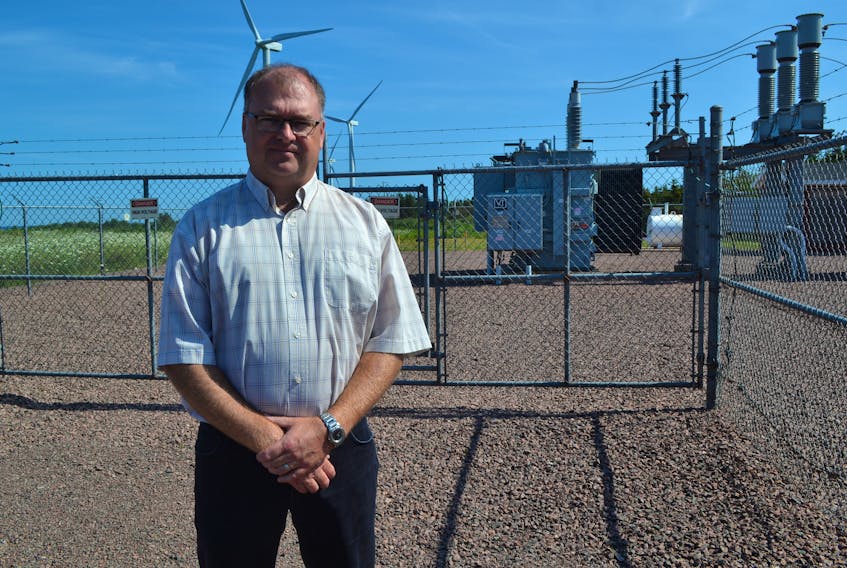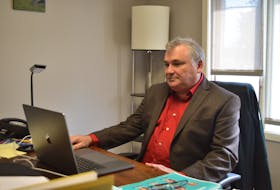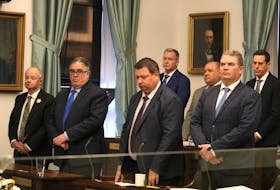NORWAY, P.E.I. — The Wind Energy Institute of Canada is about to tiptoe into solar energy at its national research facility at North Cape.
Scott Harper, executive director of WEICan said the research facility is not looking at a switch to solar, but a way to maintain production at times when the wind is not blowing.
On Friday Egmont MP Bobby Morrissey announced the Atlantic Canada Opportunities Agency, is providing a non-repayable $600,000 contribution to WEICan to help with the purchase and installation of solar panels and to increase the facility’s energy storage capabilities.
The total cost of the project is around $800,000 with WEICan covering the remaining costs.
It will allow for the creation of a 100-kilowatt solar farm beside the facility’s substation in Norway, near North Cape.
Solar, Harper explained, will help the facility’s wind farm respond to challenges that can occur when the wind is not blowing or the wind turbines are down because of a storm or a power outage. Oil in the wind turbines gearboxes must be kept warm even when the blades are not turning so that the turbines can be switched on again as quickly as possible when conditions permit. Solar energy, in tandem with power supplied from a battery storage system, could help keep the oil warm while reducing the energy demand from idle turbines.
“Renewable energy is a broad area. I think, at our core, wind is where we’re going to be. The resource here is why we’re here. We’ve cut our teeth on that,” said Harper. “We’re interested in getting more engaged with solar, but I think, frankly, it will be what solar does as a complement to wind.”
In the end, it doesn’t matter to the consumer where the power comes from, he agrees. “The battery doesn’t care and, frankly, your house doesn’t care once it gets in.”
Morrissey acknowledged WEICan’s expertise in green energy production. The research facility at North Cape has been operating for 38 years. He said the North Cape area has always been receptive to wind energy and has one of the best wind regimes in the region. We’ve embraced it and we should also benefit from that.
WEICan to study green energy options for Tignish port
Besides the $600,000 ACOA is providing the Wind Energy Institute of Canada to expand into solar energy it is providing the national research facility with $60,000 to conduct research to help the Tignish Harbour Authority and Tignish Fisheries/Royal Star Foods explore green energy alternatives.

Port Authority manager, Russell Gallant said it is something the fishermen and the fish processor have been interested in pursuing.
“We toyed around with putting several solar panels at least provide enough energy to provide the consumption that we as a harbour authority consume,” Gallant said . Besides the 60 street lights that illuminate the area, Gallant said many of the boats require nighttime power for their electronics and other equipment.
He said the port and Royal Star combined consume about 1.5 million liters of diesel and about three-quarters of a million dollars worth of electricity annually. “Electricity is a big cost.”
He said the two organizations believe green energy could help reduce their energy costs and their carbon footprint.
The $60,000 is just for a study, Gallant said, estimating with could cost five to seven million dollars to get the actual infrastructure in place if the research project deems it feasible. To boost the feasibility, they hope to involve other energy consumers in the same general area.
Scott Harper, executive director of the Wind Energy Institute of Canada, suggested there might be a possibility for a microgrid to be erected near the fishing port, but he stressed everything is still on the table. A steering committee made up of representatives from the port authority and Royal Star has held an initial planning meeting.
Gallant said the study will look at different green energy options as well as energy storage.









